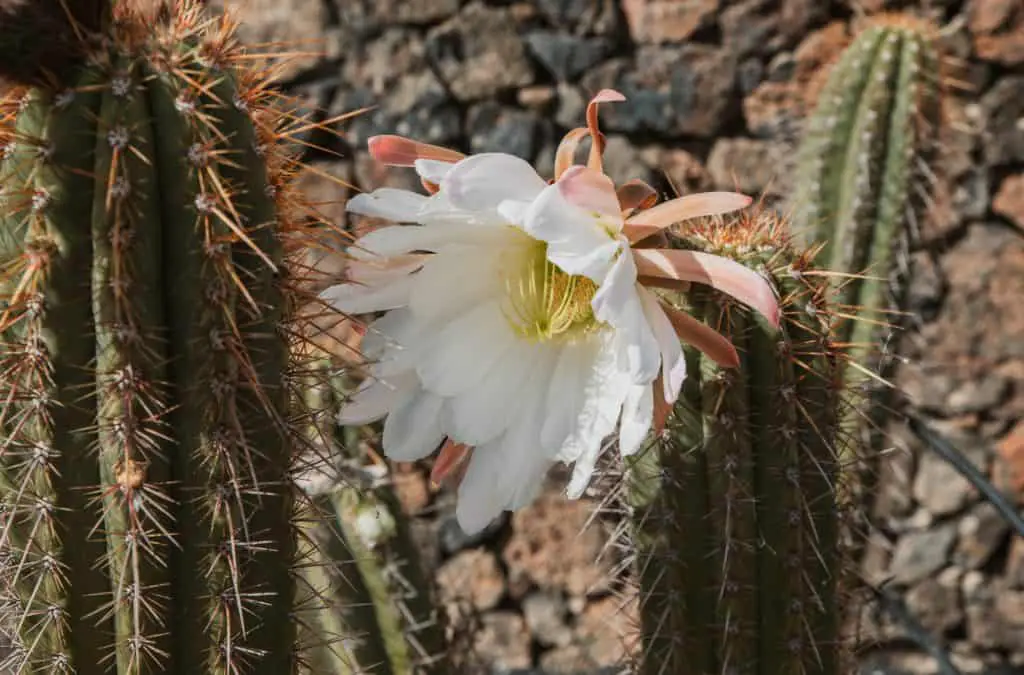The Peruvian Torch Cactus is a branching columnar cactus native to the Andes Mountains in Peru. This cactus is blue green in color with rounded ribs that have clusters of yellow or brown spikes, varying in size, running horizontally down each rib. It also has large red or white flowers during its blooming season in spring and summer.
Peruvian Torch Cactus can be identified by their unique tall and slender shape, large rigid spikes, as well as their showy flower.
Peruvian Torch Cactus Care
The Peruvian Torch Cactus is a hardy cactus that has minimal care requirements and therefore is a great choice for beginners in gardening.
Lighting Requirement
Peruvian Torch Cactus requires plenty of indirect sunlight, about 4 to 6 hours each day. This plant will require more sunlight during the spring up until late summer, and less in the wintertime. Direct sun exposure may be too intense and can cause sunburn on the cactus. If this occurs, you will notice the cactus weaken and begin to brown. Move the cactus into the shade immediately and over time it will heal, although the brown spots will remain permanently. Severe sunburn may cause your cactus to die. Young cactus will require more protection from the sun than mature cactus, so opt to keep your baby Peruvian Torch in a more shaded area.
Soil Type and pH Requirement
The Peruvian Torch Cactus prefers soil that is sandy and well-draining. You can use regular gardening soil as a base and add sand for texture, perlite for extra drainage, and peat moss for a bit of moisture retention. It is recommended to add gravel as well to create a more fast-draining blend for your cactus. An ideal blend would be 30% soil, 30% sand, 20% perlite, 10% peat moss, and 10% gravel. Peruvian Torch Cactus also favors slightly acidic soil, so maintain a pH level between 5.5 and 6.5.

Watering Requirement
You Peruvian Torch Cactus will need to be watered about once every 7 to 10 days. This cactus will require more frequent waterings during its blooming season in spring and summer but should be watered less during the wintertime. Reducing waterings to once every 2 to 4 weeks in the winter. The most ideal watering schedule for your Peruvian Torch Cactus will depend on the size of the plant as well as the conditions of its environment. The soil should be mostly dry before your next watering, so monitoring the soil each week will allow you to find the best schedule for your plant. While the soil should be dry before your next watering, you should make sure to water the cactus deeply, soaking the soil and allowing excess moisture to drain completely. Ensure you do not get the stem or branches of the cactus wet by only watering the soil, or alternatively, use the bottom watering system for this cactus.
Temperature Requirement
The Peruvian Torch Cactus prefers to be kept in tropical environments, so keeping the temperature between 65°F and 80°F (18°C to 26°C) is recommended. While this cactus favors temperate temperatures, it is quite hardy and is resistant to temperatures as low as 15°F (-10°C). The Peruvian Torch Cactus can even withstand hard frost and freezing temperatures for a short time, although it should not be left to endure extreme winter conditions for prolonged periods.
Hardiness Zone
Peruvian Torch Cactus, being native to South America, does well in the conditions of USDA hardiness zones 9 through 11. If you live within these zones, you may keep your cactus as an outdoor plant, so long as you experience only mild winters. If you live in an area with high humidity, be sure to monitor the health of your cactus and do not overwater, since the moisture in the area will keep the soil from drying out as quickly as it would in arid climates.
Fertilization Requirement
The Peruvian Torch Cactus should only be fertilized during its growing season in spring and summer. Providing this cactus with a balanced fertilizer once a month during this time will be sufficient for the plant. Deliver the fertilizer during or after a watering. The Peruvian Torch Cactus will not require any fertilization in winter when its growth has slowed.
Peruvian Torch Cactus Propagation
The Peruvian Torch Cactus can be propagated from both cuttings and seeds.
Propagation by seeds: Peruvian Torch Cactus seeds can be purchased at a local gardening store or online. Seed planting should occur in spring or summer when the cactus experiences most of its growth. Using a small clean pot, plant the seeds and cover with well-draining soil blend that is appropriate for this species. Water the soil immediately and place in a spot that will provide the cactus with indirect sunlight. You may also use a plastic bag with holes cut into it and place that over the pot until you see sprouting. Continue to provide the cactus with regular care.
Propagation from cuttings: Find a healthy stem and use a sterile tool to cut a piece that is 3 to 4 inches in length. Place the cutting in a cool spot and allow it to dry for at least 24 hours, this will help to prevent root rot or fungus from developing in your new plant. Prepare your pot with the proper soil blend, water the soil, and allow it to fully drain before placing your cutting in the pot. Plant the cutting so the bottom 2 inches are covered in soil. Provide the cutting with regular care.

Peruvian Torch Cactus Size & Growth Rate
The Peruvian Torch Cactus is a fast-growing species of cactus and can grow from 10 to 20 feet tall. This cactus should grow a couple inches in height annually, although if provided with proper care it can grow as much as 5 feet in a year. The Peruvian Torch Cactus will grow upright but as it begins to reach its full height it may begin to arch. As the cactus matures, the growth will naturally slow and eventually the cactus will stop growing altogether.
Problems Growing Peruvian Torch Cactus
Although the Peruvian Torch Cactus is a hardy species, it can still be susceptible to pests and diseases. Here are some of the common issues you may see while caring for this cactus.
- Cactus Rot: Cactus rot is an infection typically caused by fungus or bacteria. Cactus rot can be seen in two forms. Dry rot, usually caused by underwatering, and soft rot, usually caused by overwatering. Dry rot is characterized by a lack of growth and dry patches along the stem of the cactus. This type is typically harder to notice early on since the cactus starts drying out in the roots and on the inside. Soft rot is recognizable by wet, shriveled stems with black or brown patches. If you notice these symptoms in your cactus provide treatment immediately, removing affected parts, repotting with fresh soil, and using a fungicide or bactericide on the cactus.
- Yellow Cactus: If you see this yellow discoloration on your cactus, it may be a result of inadequate nutrients in the soil. However, if that is not the case, it is more likely a disease known as “Cactus Jaundice”. Cactus Jaundice has no treatment so providing proper care as a form of prevention is best to avoid seeing this disease in your cactus.
- Spider Mites: Spider mites are small, red pests that leaves behind small webs, and will ultimately kill your plant if left untreated. Regularly check the stems and branches of your cactus. Signs of spider mites include dry, brown spots or a rusty brown discoloration on the plant. If your Peruvian Torch Cactus displays symptoms of a spider mite infestation, quarantine the plant immediately and treat with a pesticide or arachnicide.
- Mealy Bugs: Mealy bugs are another pest you may encounter on your cactus and can also kill your plant if they are not treated. Mealy bugs leave a distinct white, fluffy residue all over the infected plant. If you see signs of these bugs, isolate your plant from others and provide immediate treatment. You can remove these pests from your cactus by spraying it with a high-pressure hose or by using a cotton swab dipped in rubbing alcohol to wipe the bugs off. Once the mealy bugs have been removed, spray the plant with a mixture of water and rubbing alcohol, or treat with a pesticide.
Peruvian Torch Cactus Flower
The Peruvian Torch Cactus is a flowering plant. The flower, referred to a grandiflora, is a large flower that is typically red or white in color and has a lifespan of about 7 days. The Peruvian Torch Cactus will typically flower in abundance, with 50 or more flowers per cactus, only 2 or 3 days a year during its blooming season. You may also see smaller quantities of flowers, only 1 or 2, blooming several more times throughout the year. The amount of times you will see flowering depends upon the specific variety of cactus, its age, and the care and conditions it is provided with.
Does Peruvian Torch Cactus Produce a Fruit?
Peruvian Torch Cactus does produce an edible fruit that provides small amounts of water and nutrients. However, this fruit has a sour taste and unpleasant texture, so it is not recommended to eat it.
Does Peruvian Torch Cactus Contain a Hallucinogen?
The Peruvian Torch Cactus contains an alkaloid known as mescaline, giving this plant hallucinogenic properties when ingested. This cactus has been used by indigenous Peruvians in shamanic rituals and spiritual healing for thousands of years and is considered a sacred plant.
Where Can I Find Peruvian Torch Cactus for Sale?
The Peruvian Torch Cactus can be found in local gardening stores or online from specialty shops. The average price for this cactus ranges from $10 to $60, depending on the size of the cactus being purchased.
Peruvian Torch Cactus vs San Pedro Cactus
The Peruvian Torch Cactus is commonly mistaken for the San Pedro Cactus. These two species have plenty of similarities including being native to Peru, having hallucinogenic properties, blue green coloration with white flowers, and growing in a columnar structure with rounded ribs. However, there are also several differences which can help you tell these two apart from one another. The San Pedro Cactus has fewer ribs with smaller spikes that run along each rib in a more uniform pattern than that of the Peruvian Torch Cactus. The San Pedro also has larger flowers and an edible, sweet, and red-skinned fruit, unlike the poor tasting fruit from the Peruvian Torch Cactus. These two species are both fast-growing cactus and have the same general care requirements.
